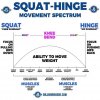You are using an out of date browser. It may not display this or other websites correctly.
You should upgrade or use an alternative browser.
You should upgrade or use an alternative browser.
Other/Mixed Squat-Hinge Spectrum
- Thread starter watchnerd
- Start date
Other strength modalities (e.g., Clubs), mixed strength modalities (e.g., combined kettlebell and barbell), other goals (flexibility)
- Status
- Closed Thread. (Continue Discussion of This Topic by Starting a New Thread.)
The curve seems a bit exaggerated.
For example, it appears one could back squat twice as much as front squat, where for me the two are much closer (80 kg front, 91 kg back, as of last test a few months ago).
Also, back squat appears to be higher than conventional deadlift... not true at all for most people (136 kg for me on DL).
In fact, it might be interesting to test 1RMs in all of those movement and plot one's own graph.....
Anyway, it's a neat representation of the movement continuum and what is emphasized.
If StrongFirst were to do one (the "SFL Clock" is the closest thing), Zercher squat would need to be on there!
For example, it appears one could back squat twice as much as front squat, where for me the two are much closer (80 kg front, 91 kg back, as of last test a few months ago).
Also, back squat appears to be higher than conventional deadlift... not true at all for most people (136 kg for me on DL).
In fact, it might be interesting to test 1RMs in all of those movement and plot one's own graph.....
Anyway, it's a neat representation of the movement continuum and what is emphasized.
If StrongFirst were to do one (the "SFL Clock" is the closest thing), Zercher squat would need to be on there!
There is too much individual variation amongst lifters to make a chart like that.
-S-
-S-
watchnerd
Level 8 Valued Member
There is too much individual variation amongst lifters to make a chart like that.
-S-
I've seen simpler ones that didn't have the vertical axis that used EMG data to assign points on the left / right spectrum.
pet'
Level 8 Valued Member
Hello,
It could be interesting to see also the "measurements" of the people who did this study. Indeed, even if I am not a weightlifter, I guess some moves are easier for someone shorter and some other harder. Depending on the size of the sample, it could greatly alter the results.
Plus,maybe some of them works more on the DL or on the Sq. This could explain as well why some results can be "surprising": if one does not train the DL, then from a statiscal standpoint, his DL can be lower than his Sq, comparing to someone who train equally both moves. Maybe there's also a better transfer from Sq to DL (or the other way around) ?
Like all the studies, it can be hard to find something without any bias and or (over) simplification.This study can give some perspective. From there we can see how we compare to it but nothing prevents us to compare to other study as well.
Kind regards,
Pet'
It could be interesting to see also the "measurements" of the people who did this study. Indeed, even if I am not a weightlifter, I guess some moves are easier for someone shorter and some other harder. Depending on the size of the sample, it could greatly alter the results.
Plus,maybe some of them works more on the DL or on the Sq. This could explain as well why some results can be "surprising": if one does not train the DL, then from a statiscal standpoint, his DL can be lower than his Sq, comparing to someone who train equally both moves. Maybe there's also a better transfer from Sq to DL (or the other way around) ?
Like all the studies, it can be hard to find something without any bias and or (over) simplification.This study can give some perspective. From there we can see how we compare to it but nothing prevents us to compare to other study as well.
Kind regards,
Pet'
T-Rex life
Level 2 Valued Member
I think, considering the target market for John Rusin, this chart is fine. Sure, there will differences but that's with anything.
wespom9
Level 6 Valued Member
Dan John definitely was the one who came up with that concept, at a minimum the X-axis. I hope this isn't against the rules but I am pretty sure Rusin has copped some things before, if I remember right he copied an intro from another podcast for one of his own years back, not sure what came of that.
The parabola has nothing to do with ## weight I would say. Nothing new on X-axis DJ didn't describe many years ago
The parabola has nothing to do with ## weight I would say. Nothing new on X-axis DJ didn't describe many years ago
TimothyGander
Level 5 Valued Member
The "ability to move weight" thing seems to be a gimmick intended to differentiate this graph from dozens of others like it that have been created since Dan John introduced this concept. It seems similar to Starting Strength's marketing in harnessing a kind of modern cargo cult: there is a graph with two axes and a nice curved line, scientists use these all the time, so it's scientific (and hence good, and true, and smart, and high status), right? Right?
Last edited:
- Status
- Closed Thread. (Continue Discussion of This Topic by Starting a New Thread.)

